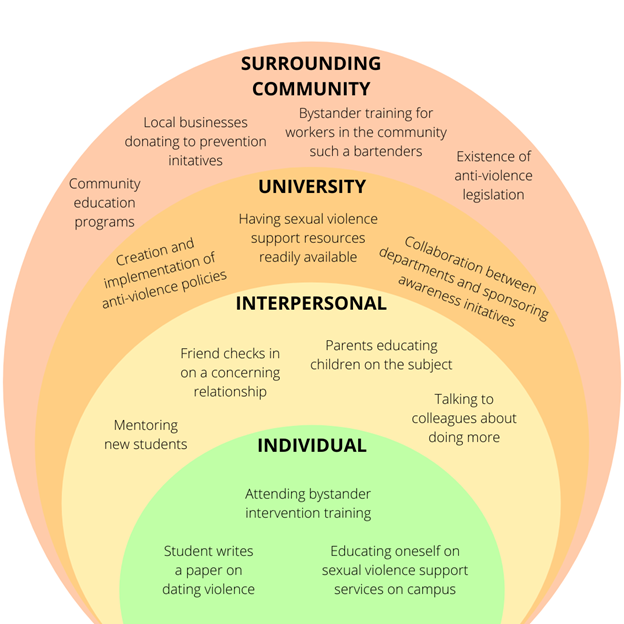Background
A bystander is someone who is a witness to an event or situation. Active bystander intervention training aims to provide all member of a campus community with the skills to recognize and respond to sexual violence. Active bystander intervention training views sexual violence as a societal problem in which everyone can play a role in preventing. It aims to help change social norms (e.g., victim blaming) and encourage people to be both proactive and reactive to situations in which sexual violence may occur.
This training is grounded in a socio-ecological model (below) which allows learners to consider how actions and interaction at multiple levels can both perpetuate violence and be places for intervention. Research suggests that the connection to community belonging shows promise in facilitating bystander behaviour (Baynard et al., 2009; Bennett et al., 2014; Casey & Lindhorst, 2009; Levine et al., 2020; McMahon et al., 2019).

This training takes learners through the 5-step model of bystander intervention (Baynard et al., 2009; Bennett et al., 2014). Following promising practices outlined by Baynard et al. (2009, p. 450), this training intentionally wove the following components throughout:
- Including information to increase knowledge and decrease about when and where sexual violence occurs
- Directly asking all members of the campus community to play a role in ending sexual violence
- Provide learners with the opportunity to develop and practice a range of skills in order to feel more confident in being an active bystander; and
- Help learners consider their own physical and emotional safety when considering options for intervening so that the benefits of safely intervening outweigh the barriers.

Image descriptions
Social-Ecological Model and Active Bystander Intervention image description.
A diagram with four semi-circles on top of each other to show the different levels where sexual violence can be prevented. They are as follows:
- Individual. This can include attending bystander intervention training, a student writing a paper on dating violence, and educating oneself on sexual violence support services on Campus.
- Interpersonal. This can include mentoring new students, friends checking in on a concerning relationship, parents educating children on the subject, and talking to colleagues about doing more.
- University. This can include the creation and implementation of anti-violence policies, having sexual violence support resources readily available, and collaboration between departments and sponsoring awareness initiatives.
- Surrounding community. This can include community education programs, local businesses donating to prevention initiatives, bystander training for workings in the community such as bartenders, and the existence of anti-violence legislation.
The 5-Step Model of Bystander Intervention image description.
- Noticing. Bystanders first must notice the incident that is taking place.
- Interpreting. Interpret the situation as harmful/emergency. decide if you have a responsibility to act.
- Assuming responsibility. Decide how you will intervene and if you need to get others involved.
- Have the skills to intervene. Learn the skills and strategies to intervene. Brainstorm situations before they happen and practice.
- Intervene. When possible, ask for consent before you intervene.
End of chapter.

